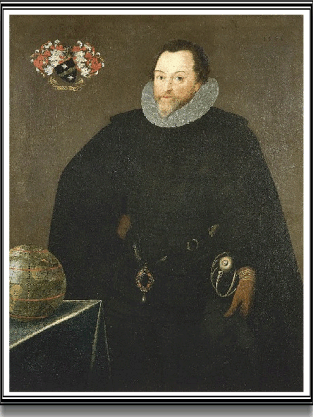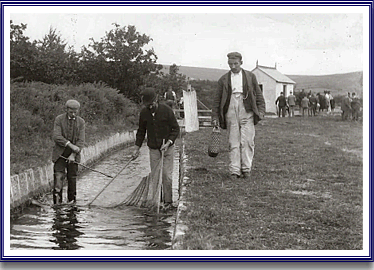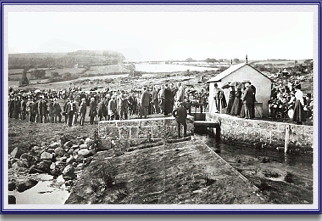
In the 16th century the importance of Plymouth grew and accordingly so did its population. It then soon became apparent that the existing water supply was insufficient for the demands placed upon it. So in 1559/60 a Mr Forsland of Bovey Tracy was commissioned by the Plymouth Corporation to carry out survey with a view to bringing a supply of fresh water to the town. For some reason this survey never took place until 1576 when Robert Lampen lead a team of surveyors in search of a route for a leat. Thus having found that the River Meavy and it’s watershed would provide the water source a Water Bill was submitted to Parliament in 1584. The Bill gave permission to:
“digge and myne a cliche or trenche contayninge in breathe betwene sixe or seaven foote over in all places throughe and over all the lands and grounds lyeing betwene the said towne of Plymouth and anye part of the said ryver of Mewe als said Meyve and to digge, myne and breake, baulk, cast upp all and al mener of rockes, stones, gravel and sandes and all other lets in anye place or groundes for the conveyance or necessaire conveyenge of the same ryver to the said towne…“
This was handed on to a committee who amongst its members held Sir Francis Drake. The bill received Royal Assent on the 29th of March 1584 and work began in 1589. The main contractor for the scheme was Sir Francis Drake, and who says corruption is a recent invention. The course of the leat was about 7 feet wide and 18½ miles long, it ran from the River Meavy to Sutton Pool and was officially opened on the 24th of April 1591. The whole project cost Drake £300 which included building costs and compensation to local landowners. A team of local tin miners was used to cut the leat because of their undoubted engineering skills in leat building. It was said that on the opening day Sir Francis Drake, mounted on his white horse, rode escort to the waters as they flowed down the new leat to Plymouth. This leat became known as ‘Drakes Leat’ and provided water to the Plymouth area for over 300 years.

Drake the ‘Leat Builder’ of Plymouth
Sometime after Drake brought the water to Plymouth it was decided to celebrate the fact by holding an annual ‘Fyshinge Feaste’. The actual ceremony consisted of the Mayor of Plymouth and his council going to the head weir of the leat where official toasts would be given. The first involved filling a goblet with water taken from the leat and then each person present would partake of the goblet and toast “to the pious memory of Sir Francis Drake.” Another goblet is then filled with red wine, this is then handed to the Lord Mayor by the City Treasurer and Chamberlain. The Lord Mayor then makes a toast saying, “May the descendants of him who brought us water never want wine,” the goblet is then passed around the assembly. There are inscriptions on both goblets, the first one reads, “The Guift of Sir John Gayer Alderman of London Ano Domini 1648.” The second reads, “The Gyft of John Whyt of London Haberdasher to the Mayor of Plymouth and his Brethren forever to drink crosse one to ye other at their feastes or meetinges who died 5th June 1585.” Following this the whole party retire to the Lodge lawn where a luncheon is served, latterly in a marquee. Whilst the luncheon is being served men go out and catch a large number of trout from the leat. After lunch the party then inspect the leat and its banks until they end up at a convenient inn where a sumptuous dinner is served consisting of the trout caught earlier in the day.

Fishing for the trout dinner.
In 1633 Bartholomew Nicholls visited Plymouth and remarks about the “Mayor’s Annual Survey of the Water Works,” this was possibly the forerunner of the ‘Fyshinge Feast,’ The ‘Fyshinge Feaste’ has been held every June since its inception with the exception of a few years, the year of the ‘Foot and Mouth’ being one. Originally this was a free feast but as with everything today one has to purchase tickets. This ceremony is said to be one of the oldest in Britain and has changed very little over the 400 years. Today the luncheon consists of local trout, salads, strawberries and cream. The location however has changed as in 1898 the upper portion of the leat disappeared under the Burrator Reservoir.

The ‘Fyshinge Feaste’ at Head Weir – 1890
One other legend that is attached to Drake’s Leat is that in 1660 the waters were drained out and replaced with wine which flowed for 2 days. The purpose behind this was to celebrate the restoration of the monarchy and what a way to mark the occasion!
“Who with fresh streams refreshed this town that first,
Though kist with waters yet did pine with thirst.“
Written on a 1594 picture of Sir Francis Drake
 Legendary Dartmoor The many aspects past and present of Dartmoor
Legendary Dartmoor The many aspects past and present of Dartmoor

Does the Fyshinge Feaste ceremony and dinner still take place? I’ve tried in vain to find out from both Plymouth City Council and South West Water, but nobody seems to know anything about it.
Not sure about this year but it definitely took place last July – http://www.okehampton-today.co.uk/article.cfm?id=429820&headline=Annual%20fishing%20feast%20at%20Burrator§ionIs=news&searchyear=2018
Morning yes it was yesterday
Regards Phil nottle